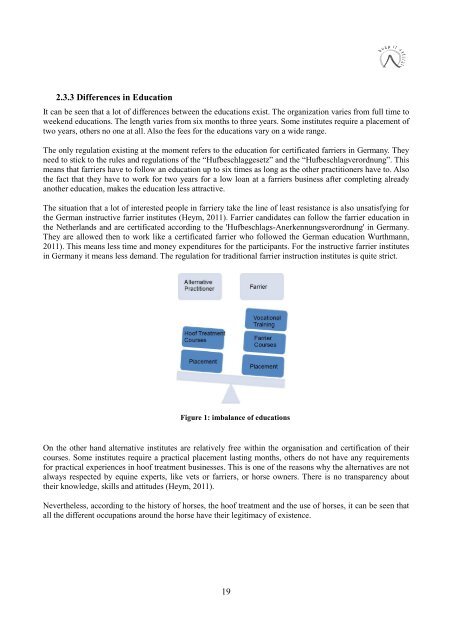Bachelor Thesis - Christina Kuenen - Hufpfleger
Bachelor Thesis - Christina Kuenen - Hufpfleger
Bachelor Thesis - Christina Kuenen - Hufpfleger
You also want an ePaper? Increase the reach of your titles
YUMPU automatically turns print PDFs into web optimized ePapers that Google loves.
2.3.3 Differences in Education<br />
It can be seen that a lot of differences between the educations exist. The organization varies from full time to<br />
weekend educations. The length varies from six months to three years. Some institutes require a placement of<br />
two years, others no one at all. Also the fees for the educations vary on a wide range.<br />
The only regulation existing at the moment refers to the education for certificated farriers in Germany. They<br />
need to stick to the rules and regulations of the “Hufbeschlaggesetz” and the “Hufbeschlagverordnung”. This<br />
means that farriers have to follow an education up to six times as long as the other practitioners have to. Also<br />
the fact that they have to work for two years for a low loan at a farriers business after completing already<br />
another education, makes the education less attractive.<br />
The situation that a lot of interested people in farriery take the line of least resistance is also unsatisfying for<br />
the German instructive farrier institutes (Heym, 2011). Farrier candidates can follow the farrier education in<br />
the Netherlands and are certificated according to the 'Hufbeschlags-Anerkennungsverordnung' in Germany.<br />
They are allowed then to work like a certificated farrier who followed the German education Wurthmann,<br />
2011). This means less time and money expenditures for the participants. For the instructive farrier institutes<br />
in Germany it means less demand. The regulation for traditional farrier instruction institutes is quite strict.<br />
Figure 1: imbalance of educations<br />
On the other hand alternative institutes are relatively free within the organisation and certification of their<br />
courses. Some institutes require a practical placement lasting months, others do not have any requirements<br />
for practical experiences in hoof treatment businesses. This is one of the reasons why the alternatives are not<br />
always respected by equine experts, like vets or farriers, or horse owners. There is no transparency about<br />
their knowledge, skills and attitudes (Heym, 2011).<br />
Nevertheless, according to the history of horses, the hoof treatment and the use of horses, it can be seen that<br />
all the different occupations around the horse have their legitimacy of existence.<br />
19


